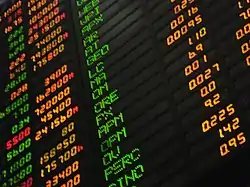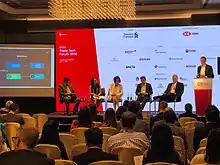| Part of a series on |
| Finance |
|---|
 |

Trade finance technology (abbreviated TradeTech, tradetech, or sometimes Trade Tech) refers to the use of technology, innovation, and software to support and digitally transform the trade finance industry.[1] TradeTech can be seen as a subcategory under FinTech.[2] As digital information becomes more readily accessible, convenient, and available, the trade finance industry is being gradually modernised and digitally transformed.[3][4] TradeTech puts a particular emphasis on the application of technology and software to modernise trade finance.[5]
Definition
TradeTech is the technology, software, and innovation that aims to enhance traditional financial methods in international trade and that is applied in making available trade finance and related services.[6]
TradeTech seeks to reduce transaction costs for businesses, lower compliance costs, and increase efficiency and transparency for firms, regulators and consumers.[7][8] The application of TradeTech results in new business models, applications, processes or products with an associated material effect on trade finance markets and institutions.[9]
This is achieved in several ways, such as introducing automation, artificial intelligence (AI), or blockchain networks to existing processes.[10]
Origins
The term TradeTech was first officially established and recognised by the World Economic Forum in a 2018 white paper, highlighting the importance of technologies such as internet of things (IoT), blockchain,[11] and artificial intelligence to facilitate international trade and support trade finance.[12] Wolfgang Lehmacher co-authored the report.
In the private sector, the emergence of private companies that typically use the cloud through software as a service to provide applications is accelerating the availability of TradeTech applications.[13] Companies are often startups founded to modernise the traditionally conservative trade finance market.[14]
The emergence of TradeTech can be linked to a broader trend of making international trade more efficient by removing barriers.[15][16] This ongoing modernisation of trade began with the invention of shipping containers in the mid-twentieth century, which largely solved the issue of reliability and safety in international trade and also greatly reduced the cost of loading and transportation.[17]
High transaction and financing costs can create a high barrier to cross border trade with high trade costs effectively nullifying comparative advantages as they render exports uncompetitive.[18]
As such, many TradeTech initiatives seek to reduce administrative and bureaucratic costs associated with financing the transporting of goods across a border.[19] This often includes applying technology to global supply chain finance, logistics, and to improve connectivity between trading partners.[20]
In the 1980s, some trade finance processes were digitised, such as with the introduction of the electronic bill of lading.[21] Meanwhile, supply chain finance initiatives emerged in the 1990s, but only began to impact the market after 2000.[22] Most recent developments have seen the rise of asset distribution providers, which seek to increase liquidity in the trade finance sector.[23] There is also a push to use blockchain in trade finance.[24]
Recent developments
According to a round table event hosted by trade financier Deutsche Bank and media company GTR, “Digitalisation of trade finance is something the entire trade finance industry agrees is vital for trade’s longevity”.[25] The rapid development of tradetech and fintech applications is cited to make reporting of environmental, social and corporate governance (ESG) factors a lot easier for the trade finance industry.[26]
Examples
Digitalisation
TradeTech received an early start with providers that developed products for financial institutions to both digitise and automate their payable and receivable processes.[27] This made it possible to upload trade documentation such as invoices and purchase orders, and then enable their validation and processing.[28]
Blockchain
The latter half of the 2010s witnessed a significant expansion of blockchain technology, and it is also beginning to be applied to international trade.[29] Specifically, the traceability and security of information of a blockchain network have been noted for its potential for increasing transparency between trade partners and supply chains, as well as the subsequent reducing the potential of fraud.[30]
Asset Distribution
Marketing sellable trade finance assets is another application emerging within TradeTech.[31] The aim of this is to create new sources of liquidity within the market, thereby increasing the funding available to businesses to continue trading.[32] The Basel Accords limit the amount of funding banks can issue to businesses as they are now required to retain a certain volume of their liquidity.[33] Furthermore, there is a perceived risk associated with issuing trade finance to businesses without credit histories.[34] This culminates into a scenario wherein Small and medium-sized enterprises (SMEs) often struggle to access the finance they require.[35] As a result, asset distribution providers seek to alleviate the pressure from banks by distributing trade finance assets to alternative investors, such as a non-bank financial institution.[36]
See also
References
- ↑ Murphy, Patrick. "Block-buster: how TradeTech could change the world". Clyde&Co. Retrieved 13 July 2020.
- ↑ "Trade Finance and Technology". Open to Export. 5 September 2017. Retrieved 13 July 2020.
- ↑ "A Guide to Trade Finance" (PDF). Deutsche Bank. Retrieved 14 July 2020.
- ↑ "The future of world trade: How digital technologies are transforming global commerce" (PDF). WTO. Retrieved 14 July 2020.
- ↑ "Is technology bridging the trade finance gap?". Pole Star. Retrieved 14 July 2020.
- ↑ "Tradetech and the problem of international coordination". Cryptoeconomics. 12 March 2018. Retrieved 13 July 2020.
- ↑ Sharma, Pranjal (8 August 2018). "Global trade tech helping efficiency and security". Business Standard India. Business Standard. Retrieved 14 July 2020.
- ↑ "7 Trade Finance Technology Trends". SCF Labs. 28 January 2019. Retrieved 13 July 2020.
- ↑ "Trade Tech: A New Age for Trade and Supply Chain Finance". Bain & Company. 10 September 2018. Retrieved 14 July 2020.
- ↑ Michel, Melodie. "5 Emerging Trends in Trade Finance for Europe in 2020". Alpine Style. Retrieved 13 July 2020.
- ↑ "What is Blockchain". www.andromedacryptogalaxy.com. Retrieved 2022-04-30.
- ↑ "Trade Tech – A New Age for Trade and Supply Chain Finance" (PDF). World Economic Forum. Retrieved 13 July 2020.
- ↑ "How is Tradetech bridging the trade finance gap in ASEAN?". UK ASEAN Business Council. Retrieved 14 July 2020.
- ↑ "Tradetech 40". Trade Finance Global. 8 January 2019. Retrieved 13 July 2020.
- ↑ "Trade barriers: EU removes record number in response to surge in protectionism". European Commission. Retrieved 13 July 2020.
- ↑ "WEF Throws Weight Behind Blockchain For Trade Finance". Pymnts.com. Retrieved 14 July 2020.
- ↑ "The simple steel box that transformed trade". BBC. Retrieved 13 July 2020.
- ↑ "Why Trade Costs Matter For Inclusive, Sustainable Growth" (PDF). WTO. Retrieved 14 July 2020.
- ↑ "Can Blockchain revolutionize international trade?" (PDF). WTO. Retrieved 14 July 2020.
- ↑ Gallaher, Mike. "4 key steps to support cross-border payments and digital trade growth". The European Sting. World Economic Forum. Retrieved 13 July 2020.
- ↑ Winter, Charlotte. "E-bills of lading". Norton Rose Fulbright. Retrieved 14 July 2020.
- ↑ "Supply chain finance: Riding the waves". Oliver Wyman. Retrieved 14 July 2020.
- ↑ "Five financial institutions join industry-wide initiative to standardise trade finance distribution". GTR. Retrieved 14 July 2020.
- ↑ "Digital trade ecosystem has obstacles — Are S2P networks part of the answer?". Spend Matters. Retrieved 14 July 2020.
- ↑ "Tradetech in Asia: seeing through the noise". Deutsche Bank. Retrieved 13 July 2020.
- ↑ Prior, Charlotte. "The incorporation of ESG in the trade finance asset class" (PDF). GIB Asset Management.
- ↑ Gustin, David. "How Big is the Supply Chain Finance Market?". Spend Matters. Retrieved 14 July 2020.
- ↑ Wass, Sanne. "Trade finance digitization faces 'tipping point' amid coronavirus lockdowns". S&P Global.
- ↑ "Blockchain for Global Trade and Commerce". Consensys. Retrieved 14 July 2020.
- ↑ "Global Blockchain In Trade Finance and Credit Insurance Market Report by Method, Application and by Regions - Industry Trends, Size, Share, Growth, Estimation and Forecast, 2020-2025". Marketwatch. Retrieved 14 July 2020.
- ↑ Saigal, Kanika. "Securitization could close the trade finance gap". Euromoney.
- ↑ Wass, Sanne. "Trade finance distribution poised to grow to $3 trillion market for investors". S&P Global.
- ↑ "Basel III: Finalising post-crisis reforms" (PDF). Basel Committee on Banking Supervision. Retrieved 13 July 2020.
- ↑ Kowit, Robert. "Trade finance as a financial asset: Risks and mitigants for non-bank investors" (PDF). Journal of Risk Management in Financial Institutions.
- ↑ Thompson, Max. "How much of the $1.5trn trade finance gap can tech bridge?". TXF. Retrieved 13 July 2020.
- ↑ "ING selects Tradeteq to distribute commodity trade finance exposure to non-bank investors". Finextra. Retrieved 14 July 2020.